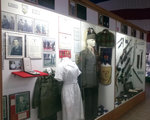

Case 62: It’s my favorite display at the Veterans Memorial Museum in Chehalis.
One side shows photos of President Richard Nixon in 1969 awarding the nation’s most prestigious military recognition to Thomas James “Jim” Kinsman, an Onalaska graduate who threw his helmet and himself onto a live grenade and likely saved seven fellow soldiers in South Vietnam.
At the center of the case is the Medal of Honor awarded to Kinsman after his quick actions Feb. 6, 1968, which cost him more than a year in a hospital recovering from injuries incurred when the grenade exploded. He served as an Army rifleman in the 60th Infantry Regiment, 9th Infantry Division.
Last week local residents said goodbye to Kinsman, 72, who died May 15 at home, a humble man who avoided the spotlight, insisting he did what anyone else would have done. He served in the Army from 1967 to 1970, and later worked as a logger and farmer. Two of his daughters babysat for us as teenagers.
What’s remarkable about Case 62, though, is that the Medal of Honor sits near a little green plaid coat, high school letterman’s jacket, Marine uniform and medals belonging to a young rifleman who paid the highest price his country could demand.
Yet his sacrifice was nearly forgotten. After his mother died, the private’s medals and mementos wound up in a secondhand store in Tenino.
That’s where Lee Grimes, museum cofounder and former executive director, purchased them.
Michael Morris Cady, the only child of Morris and Florence Cady, of Seattle, graduated in 1966 from Mount Rainier High School in Des Moines, where he participated in band, journalism and debate. He attended John Knox Presbyterian Church and finished one year at the University of Washington before enlisting in the Marine Corps July 12, 1967.
He trained at San Diego and Camp Pendleton before shipping out to Vietnam, where he arrived Dec. 15, 1967, just before launch of the Viet Cong’s Tet Offensive. He was assigned to Company C, 1st Battalion, 7th Marines, in the 1st Marine Division.
On Feb. 15, 1968, the Marines sent a reconnaissance patrol in Quang Nam Province in South Vietnam to locate and engage enemy troops massing in the hilly country west of Hill 10. Cady, serving as his squad’s point man, encountered fields cut by fire “and what appeared to be an enemy bunker beyond,” said Geoff Tillotson, another squad leader there that fateful day, who responded to the museum’s request for information about Cady.
“The platoon commander told him to press on,” Tillotson wrote in an April 2005 email. “As he approached the bunker, enemy fire cut him down and wounded a number of others. The fire power was so intense you could not distinguish one shot from another: it was one continuous roar of sound. I later assisted in carrying Cady’s body up the hill for the evacuation.”
Cady, who bled to death on the battlefield, was buried at Washington Memorial Park in SeaTac, survived only by his parents and grandparents. When they died, he was very nearly forgotten.
But thanks to Grimes, I’ll never forget his sacrifice. When the Vietnam traveling wall stopped at the museum, I took an etching of Michael Cady’s name on Panel 39E, Row 45.
Between the medals of Kinsman and Cady is the white uniform of Capt. Elisabeth Crawford, an Army nurse in the 44th Medical Brigade, which arrived in Vietnam April 24, 1966, and departed Dec. 14, 1970.
Case 62 pays tribute to an Army rifleman recognized for valor, an unsung hero in a nurse’s uniform, and a Marine who gave his life in the line of duty. Thanks to the Veterans Memorial Museum, their sacrifices will never be forgotten.
•••
Julie McDonald, a personal historian from Toledo, may be reached at memoirs@chaptersoflife.com.